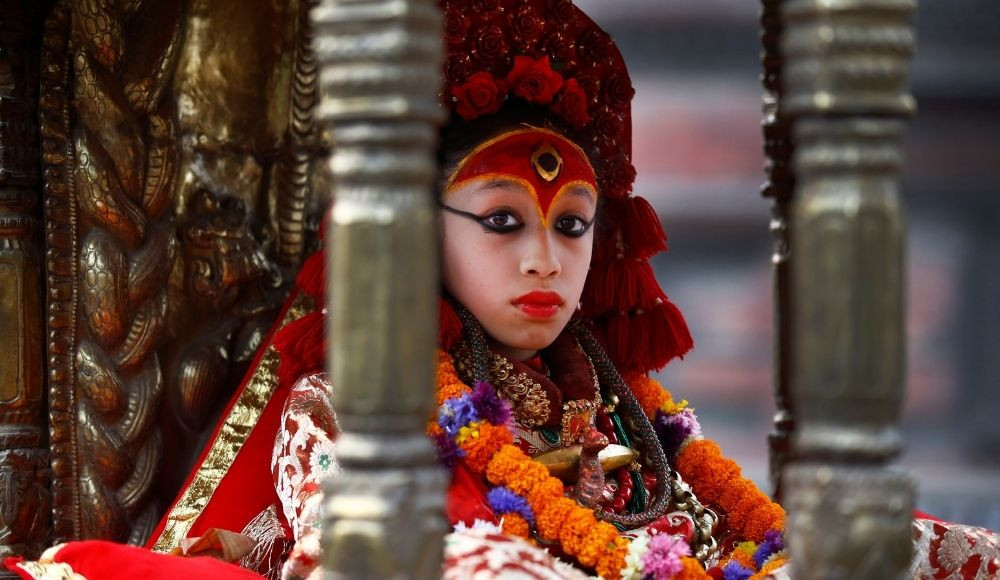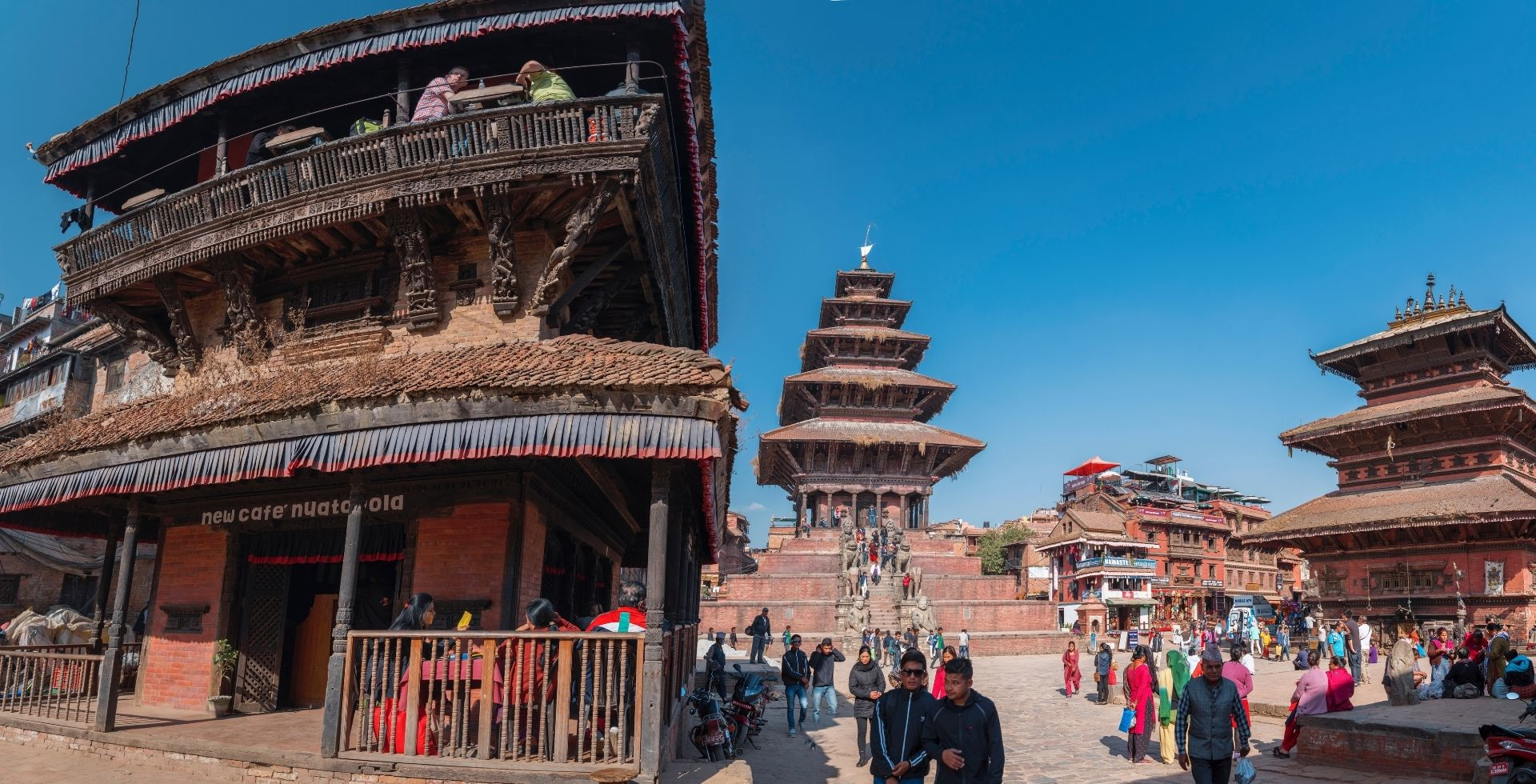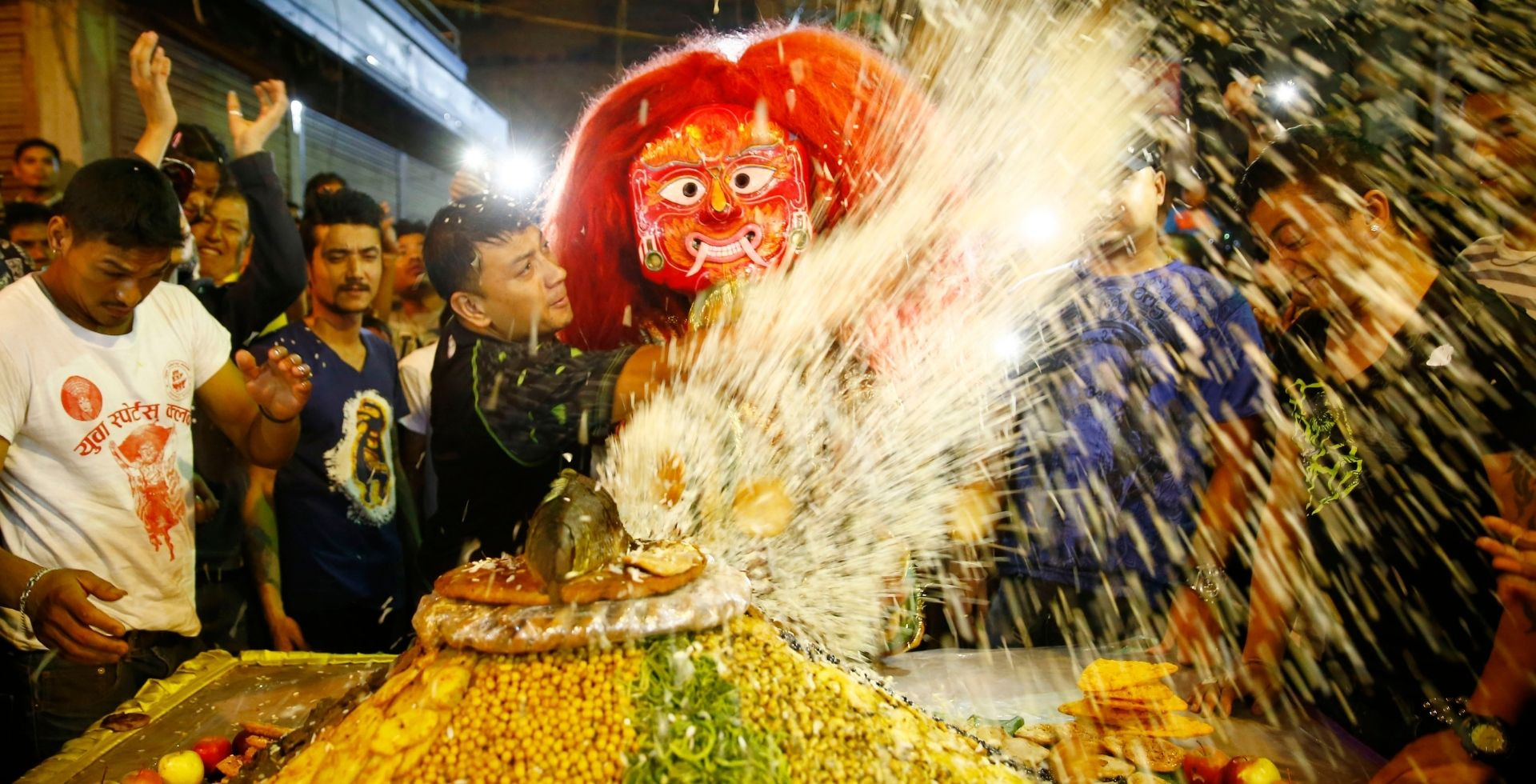Indra Jatra Festival Tour
Trip Facts
Trip Highlights
- The Living Goddess Kumari.
- Cultural and heritage sightseeing in Kathmandu.
- Bhaktapur and Patan exploreation.
- Sightseeing in Pokhara.
- Sunrise view from Sarangkot and Nagarkot.
- Multiple adventure activities in Pokhara.
Trip Overview
This Indra Jatra festival tour is a ten (10) days Nepal trip where we will observe all the main events of Indra Jatra which is the biggest street festival of Nepal and is admired not only by the locals but also by foreigners. The Indra Jatra is a festival for all the senses. The air is aromatized with the smell of incense, and the sound of the traditional drums called Dhimay Baja played by the Newari community is tranquil to the ears. For the eyes, one can behold the incarnation of Goddess Taleju also known as the living goddess Kumari. The Kumari is revered and admired as she holds the power to bring good fortune.
Additionally, the tour covers cultural heritage sightseeing in Kathmandu, Patan, and Bhaktapur. You will stay one night in Nagarkot, a popular hill station near Kathmandu to view the magnificent sunset, sunrise, and the Himalayas. Furthermore, the trip extends to Pokhara, a naturally beautiful city in Nepal. One can participate in several adventurous activities in Pokhara.
Indra Jatra is the biggest street festival in Kathmandu, Nepal which is also known as Yenya in the Newari language. Indra Jatra festival tour aims to fulfill people’s desire to experience this biggest chariot festival from close by engaging in day-to-day activity. The celebration consists of two major events, Indra Jatra and Kumari Jatra. Indra Jatra is marked by masked dances of deities and demons, and displays of sacred illustrations in honor of the deity Indra, the king of heaven. Kumari Jatra is a chariot procession of the living goddess Kumari (Living Durga).
Indra Jatra was started by King Gunakamadeva to commemorate the establishment of the Kantipur presently known as Kathmandu in the 10th century. The eight-day-long Indra Jatra falls in September and is one of the most exciting and admired festivals of the Newar community of the Kathmandu Valley. This also marks the beginning of a month-long festival season of autumn. It begins with the rising of a wooden pole (Yonsin Thanegu) made of pine in Basantapur in front of the old Hanuman Dhoka Palace, which is the foundation of the chariot.
For the pole-raising ceremony, hundreds of people gather at the palace square and in the surrounding palace temples. The chariot of Kumari, the Living Goddess is taken out in a parade through the main street of Kathmandu. Masked dancers known as Lakhey take to the streets of Kathmandu almost every evening accompanied by loud drums (Dhimay Baja) which are traditional Newari musical instruments. The festival commemorates the time when Indra came down from heaven in human form to look for a herb called Parijat (Night Jasmine).
Each night of Indra Jatra, the shrines and old buildings around Kathmandu Durbar Square are beamed with oil wicks. Each night in front of the temple of the Living Goddess, there is an enchantment illustrating the ten earthly incarnations of the Lord Vishnu. The large image of Akash Bhairavs head is put on display out in the open directly facing his temple in Indra Chowk.
In the afternoon of the day before the full moon, a euphoric crowd gathers near Hanuman Dhoka palace for the long-awaited Living Goddess chariot possession to catch a glimpse of the respected little Newari girl who has been chosen as Kumari representing Goddess Taleju. The parade of the Kumari is followed by other two small chariots representing Ganesh and Bhairav, which then is taken to different parts of the old Kathmandu through a limited pathway where people gather to watch and honor. The festival of Indra Jatra comes to an end with the lowering of the wooden pole bearing Indra's flag between religious ceremonies. Besides, there are two events. There are other events as well which are equally admired and important.
The living Goddess Kumari (The only living Deity in The World)
Kumari (the enemy of Desire), Kumari Devi is also known as the incarnation of Goddess Taleju. A Kumari is a prepubescent girl selected from the Sakhya clan of the Nepalese Newari Buddhist community, revered by both Hindus and Buddhists. The literal meaning of Kumari is virgin, while there are several Kumaris throughout Nepal, with some cities having several the best know is the Royal Kumari of Kathmandu, and she lives in Kumari Ghar ( Kumari house ) where she lives until she is dethroned. The title of Kumari is lost when the reigning Kumari suffers a cut and loses blood from her body. In Kathmandu valley, it is a particularly prevailing practice. It is believed to be the incarnation of Taleju, a manifestation of the goddess Durga. When her first menstruation begins, it is believed that the deity leaves her body.
It is believed Kumari holds the power to heal and bless people with serious illnesses, and even a glimpse of her can bring good fortune. A crowd of people patiently waits below the Kumaris window in Kumari Chowk just to catch a glimpse of her, hoping that she will pass by the latticed windows ( elaborately carved wooden windows known as Aakhi Jhal) on the third floor and glance down at them. The Kumari tradition is only followed in a few cities of Nepal, which are Kathmandu, Lalitpur, Bhaktapur, Sankhu, and Bungamati. The selection process of Kumari varies between different towns.
How is Kumari selected, you may ask?
The selection process is not that easy, traditionally Five Senior Buddhist Bajracharya, Chief Royal Priest of Taleju, and Royal astrologer oversee the selection ritual of Kumari. Some basic characteristics searched in young girls are sound health, no evidence of scars and marks on the body, uncut and blemish body skin premenstrual, and no loss of teeth. To be a Kumari she must have 32 attributes of perfection, the list of requirements is elaborated such as no history of illness, black hair, gorgeous expressive eyes, and a sonorous voice, and her horoscope is examined to ensure that it is complementary to the king's horoscope. It is important that there not be any conflict, as she must confirm the king's legitimacy each year of her divinity.
Cultural sightseeing in Kathmandu:
Kathmandu (Kantipur) is and has been the center of Nepal's history, art, culture, and economy. It has a multi-ethnic population with a Hindu and Buddhist majority. Religious and cultural Festivals from major parts of the lives of people residing in Kathmandu. The day tour around Kathmandu valley is sure to end up being the highlight of your trip to Nepal. Kathmandu has a deeply rooted cultural tradition going back centuries. It presents some of the most attractive nightclubs to the holiest Buddhist sites on the Planet.
The cultural sightseeing lets you explore the city and its surrounding valleys, bounded by green valley walls and majestic snow-capped mountains. On your trip, you will not be able to see the entire Kathmandu valley but you will be able to see the essential sites of Kathmandu like Kathmandu Durbar Square, Pashupatinath Temple, Swayambhunath, and Boudhanath Stupa, Bhaktapur Durbar Square and Patan Durbar Square, which are all listed in UNESCO World heritage sites. It will be covered in just one day since they are not far from each other. Nepal is a multilingual and multicultural country that preserves hundreds of cultural heritage of historical and cultural importance. A visit to Nepal is incomplete without witnessing at least some of the glorious historical sites.
Kathmandu Durbar Square
Kathmandu Durbar Square is one of the three Durbars Squares in Kathmandu valley, a collection of ancient temples, places, courtyards, and narrow streets. Situated in the center of Kantipur presently known as Kathmandu, the site is surrounded by monuments showing off the cultural and architectural skills of the Newari ( Native Nepali) craftsmen over the past centuries.
Pashupatinath Temple
Pashupatinath is the most sacred of the Hindu Temples and is situated on the banks of the Bagmati river on the northeastern side of Kathmandu. It is one of the main pilgrimage sites of Hindus all over the world, the temple complex is a sacred site of Hindu religion and culture. It is devoted to Lord Shiva.
Swayambhunath Stupa
Swayambhu Stupa also known as the monkey temple is situated in the western part of Kathmandu, Swayambhunath is one of the most distinct, ancient and important Buddhist pilgrim sites of Nepal. It is known as the monkey temple because of the hundred of monkeys loitering around the hills, the main stupa is a dome at the base covered by a cube structure covered by a toran, while above is Gajur (Pinnacle). A number of shrines, statues, and artifacts adorn the stupa, with a series of praying wheels also around the dorm.
Boudhanath Stupa
Boudhanath is situated northeast of the capital city (Kathmandu), it is the largest spherical stupa in Nepal with a massive mandala. It is the most important sanctuary for Tibetan Buddhists who visit the site frequently along with other Hindu pilgrims. And, also the single largest Chorent in the world. Many visitors experience spiritual peace as they do their rituals as they go around the dome beneath the peaceful sagacity eyes of the Buddha gazing at them from within the gilded central tower.
Patan Durbar Square
The Patan durbar square is situated in the center of the Lalitpur, and comprises the palaces of the Malla Kings of Patan. The complex consists of a number of temples along with massive bells, idols, and statues facing the main palace. The country yard is tiled with red bricks and tiles and the old Newari houses surrounding the area give the complex an ancient feel.
Sightseeing in Pokhara
Pokhara is best known for its majestic view of the Annapurna range. It is perhaps one of the few places where mountains above 6,000 meters can be seen unobstructed from an altitude of 800 meters within a distance of 28 km. Pokhara's calm beauty has been the subject of inspiration for many travels. Many find Machhapuchhre Razor edged (Fish tail) peak piercing the skylight or reflected in the still water of Phewa lake to be their most lasting impression of Nepal. There are many other places you can visit like David's falls, Gupteshwor Mahadev Cave, World Peace Pagoda, Barahi Temple, and Bindabasini Temple.
Pokhara is a great destination for weekend gateways as well as long relaxing holidays. Pokhara is a gateway to the Annapurna region where many trekkers find their heaven on earth. It is one of the must-visit places in Nepal.
David's fall
David's fall is locally known as Patate Chhango, which literally means underground falls. This place is one of the best places to visit in Pokhara, David's Fall in Pokhara is an extraordinary waterfall that creates a 500 feet long underground tunnel as it reaches its bottom.
Gupteshwor Mahadev Cave
Gupteshwor Mahadev cave is a major attraction of Pokhara, an excellent architectural work is the Pokhara tourist place of Gupteshwor Mahadev cave, the spiral steps that will lead you to the mouth of the cave. It is also known as the august cave of Nepal with a length that exceeds 2,000 meters, where one can hear the thundering sound of water.
World Peace Pagoda
World Peace Pagoda, also known as Shanti Stupa, is situated on the hilly edge of the Himalayas. It is a great point that offers an eye-catching view of the Annapurna. To reach the stupa one must climb about 500 steps. Near the pagoda, there are two villages, Pumdi and Bumdi above the Phewa lake's southern rim for exceptional views of the mountains.
Barahi Temple
Tal Barahi Temple also known as Lake temple is a two-story pagoda temple. It is a temple devoted to the Goddess Durga. The great devotee of Goddess Durge, king kulmandhan shah constructed the temple on the middle island of lake Phewa. It can be reached by taking boats from the shore of the Phewa lake to reach the Tal Barahi temple.
Bindhyabasini Temple
Bindhyabasini is one of the tourist destinations of Pokhara. The sacred landmark is the ideal spot to embrace tranquility in the crowded region. This temple is dedicated to Goddess Bhagwati, one of the most visited temples of Pokhara. It attracts many Hindu devotees from the Indian subcontinent.
Sunrise view from Sarangkot and Nagarkot.
Sarangkot is located on the western side of Pokhara with an altitude of 1600 meters above sea level. Sarangkot is best known for its spectacular sunrise view of the Annapurna Range and Machhapuchhare (Fish Tail) Mountain. The main mountains you will get to see from Sarangkot are Dhaulagiri (8165m), Machhapuchhare (6993m), and Annapurna (8,091m) which are breathtaking and will be a lifetime experience. It also provided a sweeping view of the city Pokhara from the extreme north to south including the Phewa Lake.
Nagarkot lies northeast of Kathmandu also known for sunrise and breathtaking views. It is especially known for its sunrise view of the Himalayas including Mount Everest as well as other peaks of the Himalayan range of eastern Nepal. Nagarkot also offers a panoramic view of Kathmandu Valley, Nagarkot is a very unique and worthwhile place to visit. Mountains that can be seen from Nagarkot are Manasalu Range, Ganesh Himal Range, Jugal Range, Everest Range, and others.
Detailed Itinerary
Arrival in Kathmandu
Observe Indra Jatra!
Observe Indra Jatra!
Final day of Indra Jatra!
Kathmandu Sightseeing
Patan, Bhaktapur Sightseeing | Drive to Nagarkot
Nagarkot Sunrise | Fly to Pokhara.
Sarangkot Sunrise | Pokhara Sightseeing
Fly back to Kathmandu
Departure
Trip Guide
The information about the Indra Jatra Festival Tour is in-depth; feel free to contact us 24/7. We will be available on WhatsApp to assist you instantly. You can write an email if this trip doesn't fit your vacation schedule and requirements. Altitude Himalaya aims to offer the best possible travel experience to the customers. Depending on the needs of the visitors and the group size, we customize each vacation package. We will put together a bespoke itinerary just for your private group.
Frequently Asked Questions
-
Can I customize the trip itinerary?
Yes, absolutely we can customize the trip itinerary to your preference in terms of duration, cost, and party size.
-
Can we see the living goddess (Kumari) up close?
Yes, you can see Kumari up close but we cannot touch or get too close to her as the Kumari Chariot is always surrounded by devotees trying to get her blessing.
-
Do we require any permit to see Goddess Kumari?
No, you don't need any special permit to see Kumari for the reason that it is a street festival, where anyone can go and see the Kumari.
Services Includes
-
All airport arrivals and departures upon requirement.
-
Private vehicle with A/C for all mentioned sightseeing and transfers.
-
Kathmandu to Pokhara and Pokhara to Kathmandu transfer by domestic flight.
-
All (9 nights) hotel accommodations are based on twin/double sharing deluxe rooms.
-
Daily breakfast at the hotel from the next day of your arrival.
-
English-speaking professional and government-licensed tour guide during your sightseeing/Indra Jatra visit to Kathmandu.
-
One local SIM card (returnable) during your stay.
-
All government and local taxes.
-
Farewell Nepali cultural dinner on your last night in Nepal.
Services Excludes
-
Personal expenses.
-
Sightseeing entrance fees. (Approx. USD 80 Per Person)
-
Lunch and dinner are excluded.
-
Nepal visa cost. (You will require 2 passport size photos and 30 USD cash to get a visa on arrival, can fill the form online before reaching)
-
Tips to the drivers and guides. (not required but recommended)
-
Services that aren’t mentioned above.
Why Travel With Altitude Himalaya?
We believe in the quality services to accommodate our guests 360 degrees need with tour personalization and customization. Our dedicated and experienced team believes not only in arranging trips, but making creating life long memories. Our travel experience within the region of Nepal, Bhutan and Tibet could make a memorable trip of yours.
Confirm Your reservation Now


TALK TO AN EXPERT
we can help you find your perfect holiday
Mr. Kiran has experience of 10+ years in tourism across Nepal, Bhutan and Tibet holiday arrangements to thousands of travellers from around the world. He will help you to figure out the best possible vacation plan according to your choice and preference.







 Duration
10 days
Duration
10 days
 Trip Difficulty
Easy
Trip Difficulty
Easy
 Highest Point
2500m
Highest Point
2500m
 Average Group Size
2-10
Average Group Size
2-10
 Trip Code
IJFTAH
Trip Code
IJFTAH
 Area
Nepal
Area
Nepal
 Start Point
Kathmandu
Start Point
Kathmandu
 Trip End Point
Kathmandu
Trip End Point
Kathmandu
 Accomodation
3 Star Hotels
Accomodation
3 Star Hotels
 Meals
As Mentioned
Meals
As Mentioned
 Transportation
On Private Basis
Transportation
On Private Basis
 10 Km
10 Km
 1350m
1350m
 Send an email
Send an email +9779823000055
+9779823000055 +9779823000055
+9779823000055